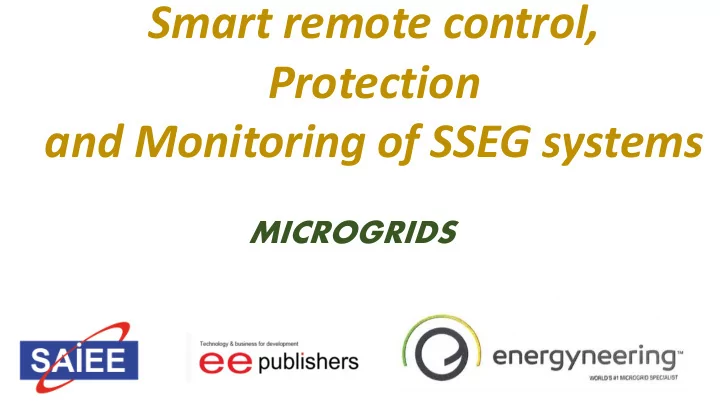

Smart remote control, Protection and Monitoring of SSEG systems MICROGRIDS
Solar is the fastest-growing renewable energy source in the world More options than ever before for making the most out of their equipment
Smart Grid Development
Asset Management Can Be a Challenge When an energy system becomes too complex, it can cause a logistical nightmare for technicians and other grid managers. real-time and TOU Using smart storage to enhance solar performance
Control and Demand Side Management • Use stored energy to reduce energy drawn during peak times and to support solar PV in the event of elements (eg cloud cover and rapid demand changes)
MICROGRIDS • Microgrids are a flexible solution for a broad diversity of stakeholders. • The advantages of microgrids range from resilience to renewable integration. • Microgrids are moving from the laboratory to broad community deployment. • Microgrids still face significant legal and regulatory uncertainties. • The ownership and business models of microgrids are still evolving.
MICROGRIDS • A microgrid is not a single concept but rather a combination of technologies and methods intended to modernize the existing grid in order to improve flexibility, availability, energy efficiency, and costs. • Distributed energy resources (generation and storage) are fundamental parts. They provide the necessary active characteristics to an otherwise passive grid. • Advanced and distributed communications. All the grid components are able to communicate. The grid operates like a power-Internet (distributed, multiple- redundant, interactive and autonomous). I.e. a Power-Net and Intelligent metering.
MICROGRIDS Challenges of Microgrids are management, control and protection Potential issues with microgrids integration into the main grid • Stability: microgrids are variable loads with positive and negative impedance (they can act to the grid as generators) • Availability: Microgrids can trigger protections (directional relays) upstream in the grid and interrupt service to other loads • Safety: When there is a fault in the grid, power from the microgrid into the grid should be interrupted (islanding)
MICROGRIDS PROTECTION SYSTEM FOR MICROGRIDS • Traditional over-current protection of LV networks will not be applicable for LV microgrids with island operation capability • Because high fault currents are not present during island operations, new protection approach is needed • Fast and selective operation is achieved by utilization of high-speed communication • Two main reasons for the speed requirements are stability and customer sensitivity
MICROGRIDS Protection Issues • However, once islanding occurs, short circuit levels may drop significantly due to the absence of strong utility grid • In this case, protection system designed for high fault currents will not respond and new protection strategies are required to ensure a safe islanding operation in a microgrid • Current differential protection is proposed to detect and isolate the feeder faults
MICROGRIDS Protection Communication and Control • Microgrid source Controller: Uses local information to control the load/storage relationship and needs to responds in milliseconds to changing events. • Energy Manager: Optimizes individual microsources to meet power supplier and customer needs by collecting system information and providing each microsource with its individual operating points (normally power and voltage set points • Protection Coordinator: which rapidly isolates feeder faults within the Microgrid and communicates feeder status changes to the Energy Manager.
MICROGRIDS Protection Communication and Control • One of the major challenges is a protection system for microgrid which must respond to both main grid and microgrid faults
Adding microgrid features to a critical power grid creates protection challenges. 400
Comparison of Fault Current in different modes of operation Mode of Operation Fault Location Fault current measured Grid without EG Main C/B 35.8kA EG in island mode EG C/B 8.96kA Grid with EG Main C/B 44.76kA
MICROGRIDS Challenges Summarized • Large fault current magnitude variations • TOC (time overcurrent) trip times increase when islanded – reduces microgrid stability • Could increase arc flash hazard • Ground source issues • Alternate relay settings may be required • Fortunately, solutions exist
MICROGRIDS • Protect feeders and sources with differential elements • Clear all faults at differential speed, islanded or grid-tied • Collect sources on main bus • Design dependable ground-source • Group critical and non-critical loads • Reduce arc flash hazards • A dependable ground-source is needed during island operation
Thank You Andre Anderson 0824749087 andre@energyneering.co.za
Recommend
More recommend